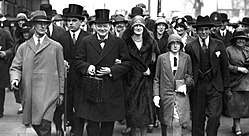Winston Churchill as Chancellor of the Exchequer, 1924–1929
Having been a Member of Parliament (MP) since October 1900, Winston Churchill lost his seat at the November 1922 general election and was out of Parliament for nearly two years until successfully standing at Epping in the October 1924 general election. Churchill had been a member of the Liberal Party since May 1904 but he now agreed to rejoin the Conservative Party, who were victorious in the 1924 election, and was appointed Chancellor of the Exchequer by the new Prime Minister, Stanley Baldwin.

War repayments and the gold standard
Becoming Chancellor of the Exchequer on 6 November 1924, Churchill moved into 11 Downing Street and formally rejoined the Conservative Party.[1] He had always subscribed to economic liberalism and, as Chancellor, he intended to pursue his free trade principles.[1] In January 1925, he negotiated a series of war repayments, both from the UK to the US, and from other countries to the UK.[2]
The Bank of England and others were calling for the UK to return to the gold standard, an idea Churchill initially opposed. He consulted various economists, the majority of whom endorsed the change; among the few who opposed it was John Maynard Keynes. Churchill ultimately relented and agreed to the measure, after which he became its supporter.[3] In April 1925, he controversially announced the return to the gold standard in his first budget at its 1914 parity.[4] The return to gold is held to have caused deflation and resultant unemployment with a devastating impact on the coal industry – the higher rate of the pound reduced the demand for already declining coal exports.[5]
In addition, Churchill's first budget included measures to reduce the pension age from 70 to 65; for widows to begin receiving their pension as soon as their husband died; and a ten percent decrease in income tax for the lowest earners which he hoped would stimulate small businesses.[6] As a counter-measure, Churchill called for a reduction in naval expenditure, arguing that it was not needed in peacetime.[7] Later, he convinced the government to introduce a subsidy for the mining industry to prevent reduction of wages in response to lower income.[8] His second budget, announced in April 1926, included taxes on petrol, heavy lorries and luxury car purchase.[9]
General Strike
During the General Strike of 1926, Churchill edited the British Gazette, the government's anti-strike propaganda newspaper.[10] After the strike ended, he acted as an intermediary between the striking miners and the mine owners. He proposed that any lowering of wages should be paralleled by a reduction in the owners' profits but no compromise could be reached and Churchill became an advocate of the miners' calls for the introduction of a legally binding minimum wage.[11]
Later budgets
In early 1927, Churchill travelled through Europe, visiting Malta, Athens, Rome, and Paris.[12] In Athens, he praised the restoration of parliamentary democracy; in Rome, he met Mussolini whom he praised for his stand against Leninism.[13]
In April, Churchill announced his third budget including new taxes on imported car tyres and wines, and increased taxation on matches and tobacco.[14] Later, he proposed abolition of local rates to relieve taxation on British industry and agriculture; eventually, after Cabinet criticism, he agreed to a two-thirds reduction and the scheme was included in his April 1928 budget.[15] In April 1929, he presented his fifth and final budget including abolition of duty on tea.[16]
References
Citations
- Gilbert 1991, p. 467.
- Gilbert 1991, p. 468.
- Rhodes James 1970, pp. 156–158, 160; Gilbert 1991, p. 469.
- Gilbert 1991, p. 469.
- Jenkins 2001, p. 404.
- Rhodes James 1970, p. 159; Gilbert 1991, pp. 470–471.
- Gilbert 1991, pp. 468–469.
- Gilbert 1991, p. 472.
- Gilbert 1991, p. 474.
- Rhodes James 1970, pp. 169–174; Gilbert 1991, pp. 475–476.
- Gilbert 1991, pp. 477–479.
- Gilbert 1991, pp. 480–481.
- Gilbert 1991, p. 480.
- Gilbert 1991, p. 481.
- Gilbert 1991, pp. 481–485.
- Gilbert 1991, p. 489.
Bibliography
- Gilbert, Martin (1991). Churchill: A Life. London: Heinemann. ISBN 978-04-34291-83-0.CS1 maint: ref=harv (link)
- Jenkins, Roy (2001). Churchill. London: Macmillan Press. ISBN 978-03-30488-05-1.CS1 maint: ref=harv (link)
- Rhodes James, Robert (1970). Churchill: A Study in Failure 1900–1939. London: Weidenfeld & Nicolson. ISBN 978-02-97820-15-4.CS1 maint: ref=harv (link)